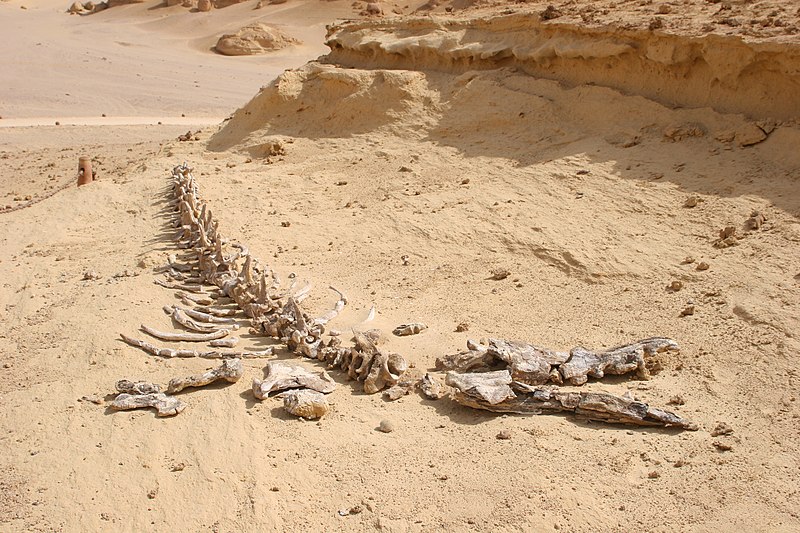Wadi al-Hitan – „Whales Valley“
Attention!
You find yourself in the nature reserve "Wadi el-Rayan", a UNESCO World Heritage Site.
Never leaves the way! Don`t destroy or collect stones / fossils.
You find yourself in the middle of the desert. It is important to perform is always enough water and food with you.
The valley of the whales can only be achieved with an all-terrain vehicle.
You are responsible for your own actions!
Introduction
The "Whales Valley" is a part of the nature reserve Wadi el-Rayan, which has existed since 1989. The protected area covers 680 mi ² and includes the west to the oasis Fayyum. Here you can find a lot of fossils remains of Archaeoceti, an early, extinct suborder of whales. The valley was closed for cars, because too many fossil were overrun and destroyed. Today, you can discover the in the eight square kilometer area fossilized skeletons of primitive whales, sharks teeth, shells and corals, and other traces of the past marine life. Also fossilized mangrove roots can be found. Of particular interest are the whale skeletons - over 250 specimens have been recovered since the first discovery in 1905. These are remnants of the genus Basilosaurus ("king lizard").

Restoration of a group Basilosaurus
Like the whales come into the desert
About 150 million years ago there existed in a huge bay in the east of the supercontinent Pangaea an ocean called Tethys. The borders were the continents Asia, Europe, Africa and Australia, but India was not a part of Asia, it was on the southern border of the Tethys. This ocean had along the continental margin extensive flat marginal seas (shelves), especially in Europe. During the Cretaceous and Tertiary, the Tethys closed between residues Gondwana (Africa and India) and Eurasia. The area of North Africa was about 40 million years ago a flat warmer ocean like the Everglades today. There were a huge variety of other marine animals and giant coral reefs.

The extent of Tethys
The geological development of the Whales Valley
The Whales Valley is a 12 mi long glen in the middle oft he desert Sahara. 40 million years ago, this glen was covered by the Tethys. Here you can found a shallow bay with a generous supply of food and protection from predators by the mangrove roots. The discovery of many young Basilosaurus fossils suggests that the Wadi al-Hitan was a preferred bay to give birth of the young animals. However, the Africa-plate continued to move on the Eurasian-plate and so the ocean became to seascape and later by raising more and more the it becames to a pond. The animals were included and poured by moving mudslide. So here was preserved a moment of geological time. A unique feature is not only the number of finds, but also the diversity of species has been preserved until today. At some of the fossil whale skeletons ("Archaeoceti") you can seen rear and front legs. These skeletons show the development in the transition from terrestrial mammals to modern deep sea whales. After the ocean was completely disappeared the ground oft he ocean lay became dried and partially fossilized. The stones were now exposed to wind and rain. Over million years, these two elements formed the rocks and discovered some of the fossils.

Fossil skeleton of a (primal) Whale "Dorudon atrox" by Christoph Rohner
Make your way to the "Whales Valley" in the dessert. Answer the following questions and send us the answers here. You can log immediately. If there is a problem we will contact you. It would be great if you could upload a picture of you / your GPS with one of the whales.
Questions:
1. How old are the rocks, where whale skeletons have been found?
2. How are the three layers called from which they are composed?
3. In which layer were the whale skeletons and fossilized mangrove roots be found?
4. Describe the appearance of such a fossilized root!

Sources:
Sampsell: A Traveler`s Guide to the Geology of Egypt
Informationboard
http://en.wikipedia.org/wiki/Wadi_Al-Hitan
http://en.wikipedia.org/wiki/Basilosaurus
http://en.wikipedia.org/wiki/Tethys_(Ozean)
http://en.wikipedia.org/wiki/Wadi_Al-Hitan
http://ngm.nationalgeographic.com/2010/08/whale-evolution/mueller-text
http://whc.unesco.org/en/list/1186
http://www.eoearth.org/article/Wadi_Al-Hitan_(Whale_Valley),_Egypt
http://www.petrified-wood.de/fundregionen/eg_west_wadi_el_hitan.htm
Happy Hunting


